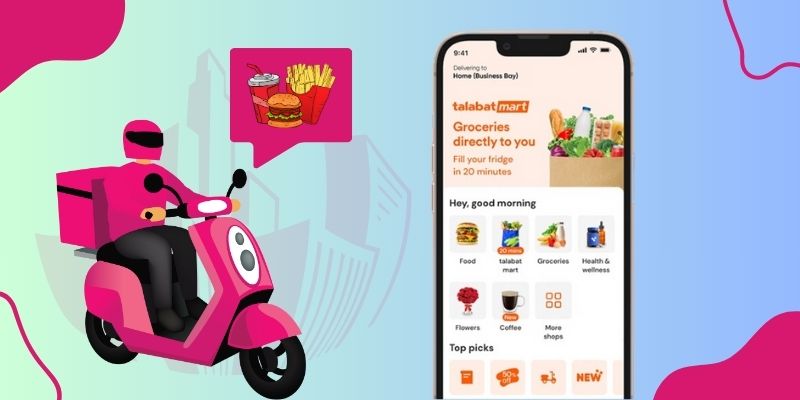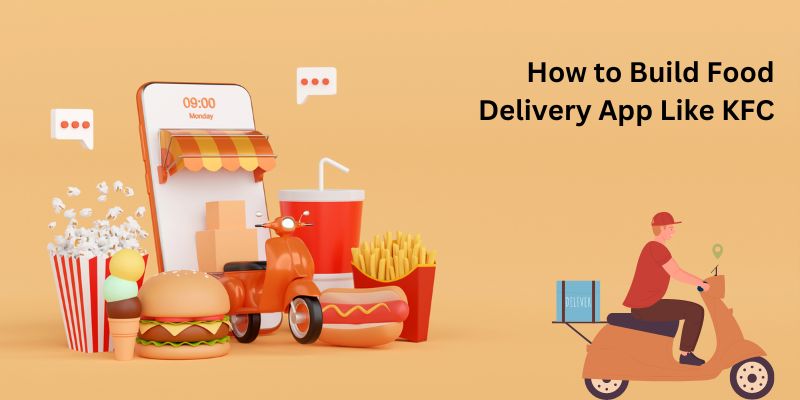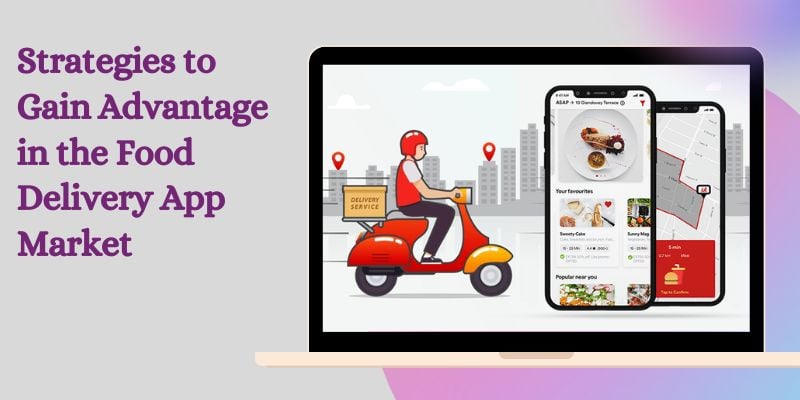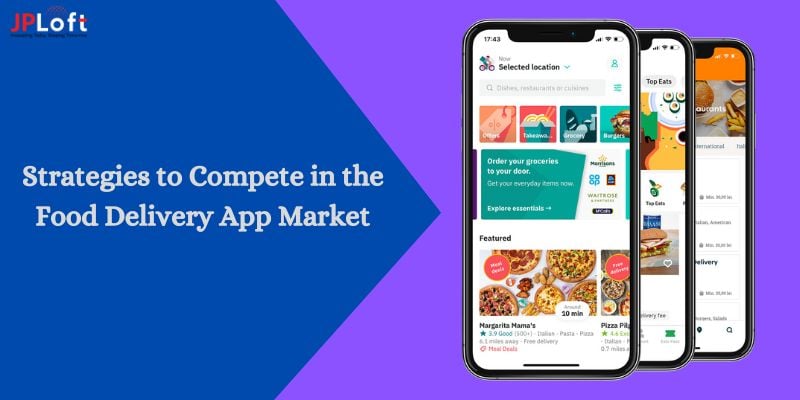Apps for food delivery have significantly improved since their beginnings due to their highly efficient process. The food delivery industry has recently experienced massive growth, fueled by consumers' changing preferences and technology's ease of use. In the wake of this, many restaurants and food service companies are utilizing food delivery services to increase their customer base and simplify their business processes.
How can we develop food delivery apps that are different from others in 2024? In this article, we'll examine the food delivery app development process in 2024 and the essential aspects to consider when developing the most successful app.
If you've considered launching your own food delivery company, now is the ideal moment to begin implementing your thoughts. But don't leap in immediately—we've seen it before. When someone wants to build an app for delivery, there are a myriad of challenges, such as which features to choose, how to choose an experienced contractor, how to make money from the concept, and so on.
Growing Demand for Food Delivery Apps
The rise of food delivery apps has revolutionized how people purchase food. With a couple of clicks on their smartphones, users can browse an array of cuisines, restaurants, and food items and then have their preferred meals delivered to their door.
This ease of use has accelerated the expansion of the food delivery sector, as a growing number of people are choosing online food ordering instead of traditional dine-in dining experiences.
The process of developing a food delivery application requires several steps that are crucial for a smooth and easy-to-use experience.
Although the big companies seem to control the market, it's inaccurate. When the pandemic hit, on-demand food delivery companies exploded worldwide and are growing in recognition.
Future of Food Delivery Sector
We do not live in the magical world or possess any power of God. This technologically driven society is the same as the world of magic, making all things possible at the touch of a button.
The popularity of online food delivery is still on the rise, but the craze won't last forever. Eventually, the growth triggered by the pandemic will slow down. However, the number of services on-premises will continue to increase despite the pandemic.
According to the data from Datassential from September to October 2020, 59% of customers who ordered food said they would keep using the delivery services after the pandemic ended.
Contact-less Delivery
In this artificial intelligence-driven age, with the use of robots and drones, there will be a need for food delivery that is not mediated by contact.
The industry attempted to implement various methods to combat the outbreak to ensure hygiene and safety protocols. In addition, consumers switched from cash-on delivery to cashless, which allows contact-free deliveries. This reduces the need for interactions and in-person contact and minimizes the risk.
Thus, contactless delivery has been the focus in recent years.
Food Delivery Business Models to Choose From
Before you start on-demand food delivery app development, it is important to choose the food delivery app's business model that is most suitable for the type of business you are operating. Here are a few you could look at:
Aggregator Business Model
The food delivery online business model provides a platform to act as an intermediary between restaurants and customers. It accomplishes this by integrating various food establishments on its platform. Users can then visit many different restaurants within one location.
If you are a food delivery start-up, you could start by implementing an option to have restaurant patrons and customers subscribe to your service. This is a better method of ensuring you profit for your company.
The top-performing applications built around this business model include JustEat, Delivery Hero, Talabat, and many more.
Order and Delivery Model
In this business model, food business owners employ a delivery service to provide fast and efficient delivery. The third-party delivery service provider decides on the fees for delivery of food orders since they handle the delivery.
This business model is ideal for restaurant owners who don't want to spend money on a delivery vehicle but would like food delivered to customers in their homes. You can partner with logistics service providers such as Swiggy, Zomato, etc. to handle the delivery. It is crucial to monitor and verify the delivery company to ensure that your services are up to par with the promises made to your customers.
Full-Service Business Model
As the name implies, you will be able to do everything from preparing the food to serving it. All of it will be handled at home, which means it will require an enormous investment. However, since you control every aspect of the process with this model, you're likely to make more. Examples of successful implementations of this type of model are Domino's and McDonald's.
How Do Food Delivery Apps Work?
On-demand food delivery solutionshave revolutionized the eating experience, by providing diners with a simple and easy platform to search, order and eat their favourite food items. Here's how food delivery service works:
Exploring Nearby Restaurants and Special Orders
Food delivery apps change the way people purchase food by giving them an array of options and a complete access to their personal preferences. In the beginning, users are offered recommendations for nearby restaurants or special orders to be delivered, improving the dining experience.
With a couple of taps on their mobiles, users can browse through a variety of restaurants, from local favourites to well-known chains. This vast database of eateries caters to different preferences and tastes, making sure that the user finds the perfect food to meet their needs.
Building a Customized Basket of Desired Items
One of the most important advantages of these on-demand food delivery applications is the capability for customers to design custom orders easily. Once they have picked their preferred dishes from the menu at the restaurant they prefer, they can add them to their shopping carts easily.
This simplified process allows customers to examine their choices before going to checkout and making a payment to ensure that they are satisfied and accurate.
Seamless Ordering and Notification to Restaurants
After completing their order, customers can begin a seamless transaction process for food delivery via the app. In just a couple of clicks, they can verify their purchase and then proceed to pay, ensuring the smoothest experience.
In parallel, the restaurant receives an email informing them of the new order and prompting them to begin preparing the food. This instant communication between the customer and restaurant guarantees prompt order processing and delivery, increasing customers' overall satisfaction.
Efficient Delivery and Customer Satisfaction
After the order has been prepared, the delivery person will be dispatched to collect it and then deliver the item to a specific address. Real-time tracking technology allows users to track the status of their delivery and get updates on the expected arrival time.
The transparency and trustworthiness of this app instill confidence in the customers and ensure satisfaction with the delivery. After delivery, customers can give feedback and ratings, which allows the app for food delivery to constantly improve its service and tailor suggestions to the individual's preferences.
Challenges of Developing a Food Delivery Application
There are difficulties with every job. This is also true for food delivery app development. These are just a few of the problems you may encounter:
App Scalability and Dependability
Food delivery apps are complex because they comprise multiple tasks that must be completed simultaneously. Are you aware of what these obligations are?
To properly handle users' data, ensure security, conduct necessary money transfers, and ensure that data is secure, a food delivery service must run back-end software.
Accessibility of the app has to be maintained, while thefood delivery app development company manages the technical aspects.
Fierce Rivalry
Like you, every restaurant owner has considered purchasing an app to deliver food to boost their business. You must make sure that your app stands above the rest since many similar ones are currently accessible.
So one of your tasks is to market your app effectively and concentrate on the correct audience by describing your company's advantages.
Find the Right Delivery Team
Working with the most suitable delivery team is your main concern if you want to deliver top-quality customer service. Unfortunately, it's difficult to identify the best team.
You can create an inventory of reliable delivery firms that will assist you.
Keeping Customers
Achieving customers isn't an issue. But, a number of food delivery companies have difficulty keeping customers for the long haul.
It is possible to maintain the loyalty of your customers by delivering a professional user experience that's simple to use, brimming with the latest features, and provides easy ordering processes.
Steps to Build a Successful Food Delivery App in 2024
The development of a food delivery application is a complex process that spans from concept to implementation. This section gives a comprehensive overview of the most important steps, which include market research, feature definition, and the selection of technology to build your app.
Pick the Business Model
Selecting the best business model is essential to the achievement of your food delivery appplication. You could choose either of these options. The aggregator model entails partnering with restaurants to display their menus on the website and making a profit on every purchase.
The full-service model entails running your delivery staff and overseeing the delivery process. Alternatively, you could consider a hybrid model that blends elements of both full-service and aggregator models to allow for greater flexibility.
Choose the Monetization Model
To make your app financially viable, you must determine the best way to earn revenues. Most monetization models offer commission on orders, which means you take a cut of every order made through your app. An alternative is to add delivery charges, which charge customers an amount for delivery.
Furthermore, you could offer high-end listings, including featured places to restaurants, in exchange for a cost. Your monetization strategy must find a balance between profits and customer satisfaction to ensure long-term growth.
Research and Decide Your Niche
Conduct market research to find particular gaps or needs in the food delivery industry. Pick a niche that matches your passions, experience, and preferences for your audience. Whether you're focused on certain cuisines or dietary preferences or catering to a certain segment of the population, identifying the right niche will help distinguish your application in a competitive market.
If you are aware of customers' specific requirements and preferences, you can customize your offerings to suit their needs efficiently.
Decide on the Food Type of Delivery App
Decide if your app is focused on delivering meals prepared from grocery stores, restaurants, or both. Knowing your market's preferences and needs will allow you to tailor your offerings accordingly.
When deciding on the food option for your delivery service, consider factors like the current logistics challenges, competition, and market trends. With a wide range of options, you'll be able to appeal to a wider range of customers and accommodate different customer preferences.
Assemble the Right Team
The development of a successful food delivery applicationrequires an array of team members with different capabilities. Developers are required to manage all aspects of app creation, designers to design a visually appealing and easy-to-use design interface for users, advertising professionals to market your app and draw in users, and operations managers to manage day-to-day operations and ensure that the app is running smoothly.
Working with experienced professionals will streamline the development process and increase the performance of your application, setting you up for long-term success.
Design the App
A user-friendly interface is crucial to keeping and engaging customers. Create a seamless experience from menu browsing to placing orders and monitoring delivery. Consider things like navigation, aesthetics, and accessibility to create a great user experience.
Focusing on usability and a simple design can increase user satisfaction and encourage more frequent use of your app.
Choose the Development Approach
Choose whether to develop an app natively for certain platforms, such as iOS or Android, or choose an open-platform solution. When deciding on the most appropriate strategy, consider factors like development costs, time to market, and user experience requirements.
Work closely with your team offood delivery app developers to benefit from their expertise and ensure the success of the method you choose to use for development. When you choose the appropriate technology and tools will allow you to create a strong and flexible application that is able to meet the demands of your intended user.
Develop the App
Collaborate with a reliable food delivery application development companyto make your app a reality. Prioritize features like user profile registration, menus, and restaurant listings, order placement and payment, real-time order tracking, and reviews and ratings.
Agile development techniques will allow you to iterate rapidly and adjust to changing requirements throughout the development process. By maintaining open communication and remaining focused on providing benefits to your customers, you can ensure the success of your app in delivering food.
Test the App
Conduct a thorough test of your app to find and correct any bugs or usability issues before it goes live. Test your beta version with a real group of users to collect feedback and improve the app based on their experience.
Quality assurance is vital for ensuring a smooth and secure user experience. By investing time and money in testing, you will lower the chance of errors and ensure that the application can meet the needs of your intended audience.
Launch the App
When you're satisfied with the reliability and security of your application, it’s time to open your app to the world. Develop a strategy for marketing to build buzz and bring customers to your platform. Review feedback from users and app performance after launch to determine areas that require more optimization and improvement. Through constant improvement and iteration of your app based on the feedback of users, you can improve retention, engagement, and, ultimately, long-term success.
So How Much Will It Cost to Develop a Food Delivery Application?
The total on-demand food delivery app development cost depends on various aspects, including a variety of options, the difficulty of developing mobile apps and integration with third-party apps, the correct mobile app development, and much more.
Let's look at the other elements and also:
App Features and Functionalities
Project Analysis and Scope Statement
UI/UX Development
App Platforms
App Deployment
App Maintenance
App Security
App Development Team
Although the cost of development could vary greatly, here's a rough estimate for developing an app for food delivery:
Basic Application: $20,000 - $25,000. (limited features, possibly being a hybrid app)
Mid-Tier App: $50,000 - $150,000 (common features like real-time tracking, separate iOS & Android versions)
Complex app: $150,000+ (advanced features such as AI in-app chat, in-app messaging and a sophisticated back-end)
Tech Stack To Consider To Develop a Food Delivery App
To develop a food delivery application, it is necessary to think about different aspects of the tech stack, such as frontend, backend hosting, and other technology that can help. This is a brief overview of what you should think about:
Frontend Development
Framework: Select the JavaScript framework to create your user's interface.
React.js, the Angular framework, or Vue.js are the most popular options.
Programming Languages: HTML, CSS, and JavaScript.
UI Frameworks: Bootstrap, Material UI, Semantic UI.
Backend Development
Programming Language: Select the backend language that best suits your team's expertise and needs.
Node.js (JavaScript)
Python (with Django or Flask framework)
Ruby on Rails
Java (Spring Boot framework)
PHP (Laravel framework)
Database
Relational Database: PostgreSQL, MySQL, or SQLite.
NoSQL Database: MongoDB, Couchbase, Cassandra (for handling unstructured data and scaling requirements).
Hosting
Cloud Platform: Select an online service provider to host your application.
AWS (Amazon Web Services),Google Cloud Platform, Microsoft Azure.
Server Deployment: Set up your backend application using services such as AWS Elastic Beanstalk, Google App Engine, or Heroku.
Database Hosting: Use managed database services offered by cloud platforms or host your database independently.
Push Notifications
Utilize push notifications to inform customers of the status of their orders, promotions, and more.
Firebase Cloud Messaging (FCM),Apple Push Notification Service (APNs) or third-party applications like Pusher.
Geolocation Services
Use geolocation to track orders, locate nearby restaurants, and show the delivery routes.
Google Maps API, Mapbox API.
Analytics and Monitoring:
Utilize tools for monitoring the performance of applications monitoring user behavior and gaining insights.
Google Analytics, Mixpanel, New Relic.
The Key Takeaway
Creating a food delivery application offers numerous advantages for customers and companies alike.
These apps provide unparalleled convenience for customers, allowing users to make reservations for their favorite food items with just a couple of taps on their mobiles and avoiding the requirement to stand in long lines or go to restaurants. Regarding delivery and restaurant services, the app effectively increases its customer base, simplifies processes, and increases sales.
By utilizing the rising trend of ordering food online, businesses will gain an edge in the marketplace and adjust to consumers' changing preferences. Partnering with a trusted food delivery app development firm is a good option for those who want to start on this path.
These food delivery app development companies offer a wealth of knowledge in the field, helping businesses at every development step - from conception to launch and beyond.
FAQs
1. How can I create an app to deliver food?
You can create the most feature-rich food delivery app in just six easy steps
Validate Your Food Delivery App Idea
Choose Your Food Delivery App Development Method
Identify Your Food Delivery Business Model
Select Your Features
Design and Development
Marketing and Launch
2. What does it cost to develop a food delivery application?
The cost to create an application for food delivery could be as low as $40k or as high as $300k. The development of the Android or iOS application for food delivery in restaurants can cost between $3000 and $15000 in India. The features and functions required will determine the cost.
3. What attributes can be included in creating an app for food delivery?
Although your app might contain some functions used by other delivery apps, you should make sure that your app has distinct features, too. Menu options such as personalizing the homepage and app feature integrations, geolocation services, options for customer reviews and ratings, a variety of payment methods, and much more are just among these.
4. What is the time it takes to create an app that delivers food?
The development of an app for food delivery on demand typically takes between two and four weeks.
However, this mostly depends upon the application's sophistication and feature requirements.
5. Do I begin an internet-based food delivery company?
To begin an online food delivery company, you must follow the steps below:
Select the segment of the market.
Know the food preferences of your customers.
Choose your area of expertise and develop your product.
Keep up to date with developments in technology.
Analysis and Research on the Market.
Choose reliable delivery personnel.
Manage the flow of cash.
Design your own website or app.
Choose the correct option for delivery online.








